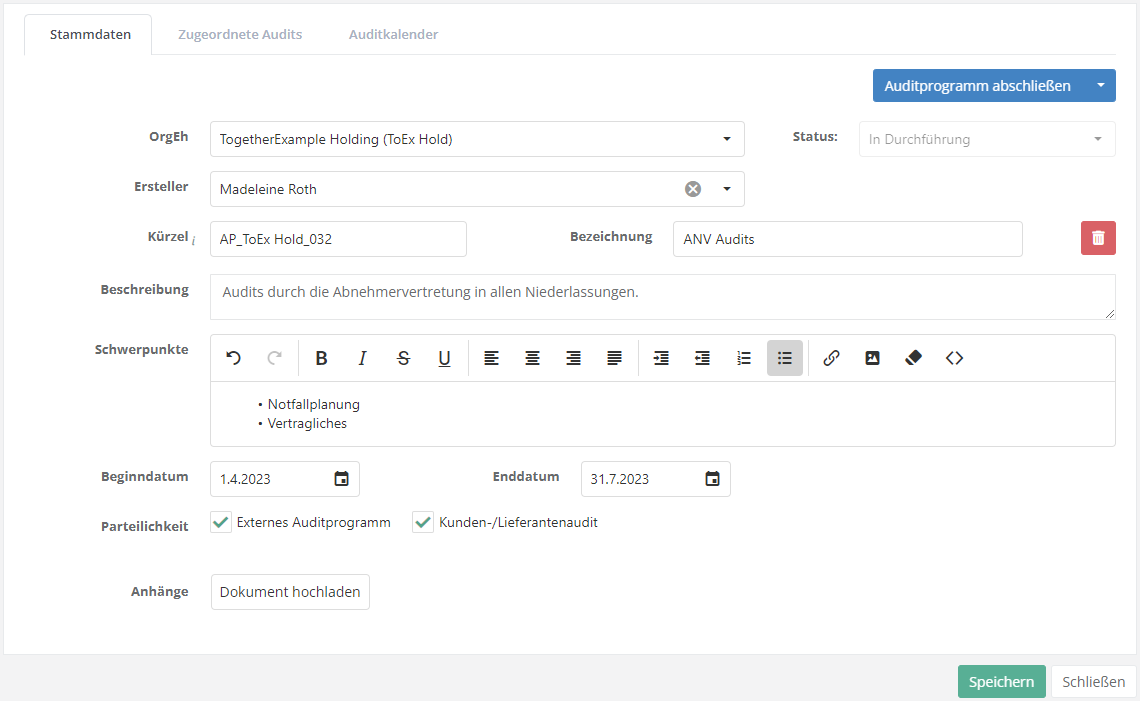Auditprogramm erstellen/en: Unterschied zwischen den Versionen
Weitere Optionen
Faha (Diskussion | Beiträge) Die Seite wurde neu angelegt: „left|thumb|903px|Master data<br clear=all>“ |
Faha (Diskussion | Beiträge) Die Seite wurde neu angelegt: „<u>Status:</u><br> * The status of an audit program is controlled by the workflow button in the upper right corner. In the screenshot above, "Complete Audit Pr…“ |
||
| Zeile 20: | Zeile 20: | ||
<u>Status:</u><br> | <u>Status:</u><br> | ||
* | * The status of an audit program is controlled by the workflow button in the upper right corner. In the screenshot above, "Complete Audit Program". More about the worklfow can be found at [[Special:MyLanguage/Auditplanung#auditprog_workflow| "Audit management → Audit planning"]]. | ||
<u>Ersteller:</u><br> | <u>Ersteller:</u><br> | ||
Version vom 27. Januar 2022, 08:14 Uhr
To create or edit an audit program, it is necessary to navigate to the audit program overview ("Audit management → Audit planning → Audit programs").
To create a new audit program, click on the "Plus" button in the overview.
To edit, the desired audit program must be double-clicked.
Afterwards the mask for creating / editing opens.
Create audit program
Once you have successfully opened the mask, you must fill it with the appropriate information and save it to create an audit program.


Organizational unit:
- The organizational unit where the audits for the audit program will be scheduled must be entered here.
Status:
- The status of an audit program is controlled by the workflow button in the upper right corner. In the screenshot above, "Complete Audit Program". More about the worklfow can be found at "Audit management → Audit planning".
Ersteller:
- Hier ist der Ersteller des Auditprogramms einzutragen. Standardmäßig wird dieses Feld mit dem zentralen Managementbeauftragten, der unter den Auditmanagementeinstellungen konfiguriert ist, vorbesetzt.
Abbreviation and designation:
- At the abbreviation you enter how the audit program is abbreviated.
- At the designation you must enter how the audit program should be called.
Description:
- Here you should enter what purpose, the audits planned in the wake of the audit program.
Schwerpunkte:
Hier können die Schwerpunkte des Auditprogramms spezifiziert werden. Audits die über dieses Auditprogramm erstellt werden, übernehmen die Schwerpunkte automatisch.
Start and end date:
.
- Here must be entered in which period, in an audit program, audits are scheduled.
externes Auditprogramm:
- Durch diese Einstellung werden aus diesem Auditprogramm erstellte Audits per Default als externe Audits erstellt.
Assigned audits
All already planned audits are displayed here. It does not matter whether these are drafts, in execution, in post-processing or already completed.

It is also possible to plan new audits for an audit program here or to assign existing audits to the audit program.
For creating/assigning a new audit click on the respective button.
.
For how to create audits, see User Guide: Create Audit.
Zum Zuordnen eines Audits, den blauen "link" Button klicken.
